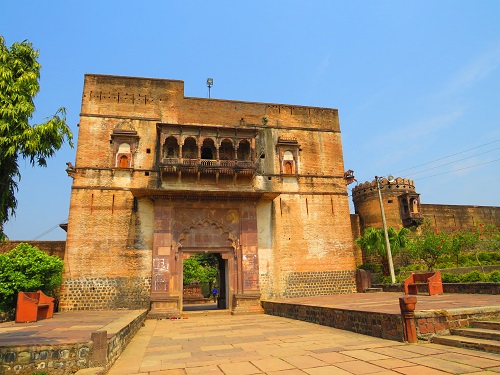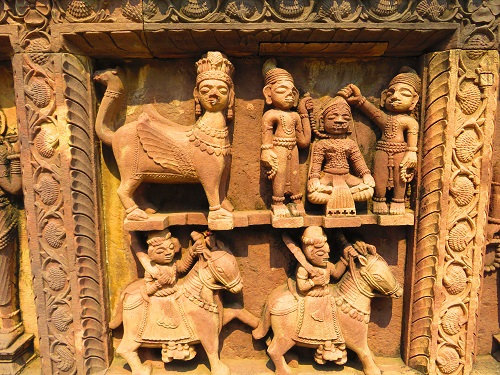It is an art gallery which few art lovers have ever visited, a heritage site that only the perseverant history buff manages to reach, an interior destination on poor roads that only the intrepid are fortunate enough to be able to explore. Welcome to the Sankaji ki Chhatri!

The route to Sankha Shyamji, Rajgarh district of Madhya Pradesh
Located in a place called Sanka Shyamji, it is deep in the heart of Rajgarh district, a couple of hours’ drive north-west of Bhopal and twenty kilometres from Narasinghgarh. After one turns off the highway, the landscape gradually changes. The road is bumpy, vehicles fewer and highway dhabas are replaced by people working in fields. Visitors to the area are few and far between and a vehicle from outside draws curious glances.
The journey takes one over a stream and suddenly, the heritage site looms on the left. The structure seems rather confusing. It has walls and battlemented, rounded bastions befitting a fort. A huge gateway with carved stone windows would have looked more in place in a palace. And from within, the shikhara of a temple rises high. This structure is the focal point of the site.

An entrance gateway that would have been suited for a palace complex
The temple-like structure stands, pyramidlike, on a high plinth formed by three successive platforms. The second of these is the biggest and is perhaps the stand-out feature of the entire complex. Depicted in stone carvings on all sides of this platform are stories from Hindu epics. Episodes from the Ramayana, anecdotes from the life of Krishna, hunting and battle scenes cover every single inch of this platform.

Cenotaph that is like a living art gallery
There are figures depicted on horseback, on elephants, on camels, in the forest, women churning butter, animals being fed. In one niche is Indra on his Airavata elephant, another shows the devas and asuras churning the ocean for nectar with Vishnu in his fish incarnation below. One niche showcases the Rajasthani folk ballad Dhola Maru. Even the corners are rounded off by figures such as that of the god Hanuman and ascetics. Incredibly, even a few bearded figures in Islamic prayer are depicted here, with the Koran also shown by their side – perhaps depicting the traders of that age. It is a collage of striking depictions that stand out as much for detail as for the isolation of the location.





Brilliantly carved panels cover the cenotaph
The style and design are overwhelmingly Rajasthani in nature, an indication of its patron builder. This living art gallery, similar to a temple in its form, is the cenotaph of a local Rajput ruler called Raja Shyam Singh, who died in battle here. Built in memorial by his queen Bhagyavati in the 17th century, it has come to be regarded as a shrine by locals from the villages around and is popularly called Shyamji ka mandir. I am not sure if it merely imagination but I felt traces of medieval Maratha art also in the place. Incredibly, given that the complex is essentially a Hindu shrine, the panels on the cenotaph include two which depict Muslims at prayer – probably a depiction of merchants who came through here or men in the service of the local ruler.


Two panels depicting Muslims at prayer
The real temple inside the complex lies directly opposite the cenotaph, accessible through a carved gateway. The shrine is dedicated to Shiva with a small, chaumukhi linga within. The structure of this shrine seems older than that of the cenotaph which may imply that the cenotaph was built near a pre-existing place of worship. The walled complex and gateway look of a later period, perhaps the 18th century. It is heartening to see the temple still in worship and not abandoned to the elements as has been the fate of many medieval structures in the region. Bearing signs of restoration work, the complex has been protected by the State Archaeology Department and credit must go to the joint custodianship between them and the simple folk of the village.
The site dominates not just the physical landscape of the village but also the mindspace of its denizens. There is a popular belief here that the place has a curse on it – that any child born in the village will be mentally or physically impacted. Hence, folks are insistent on deliveries happening just outside the village limits. Local legends attribute this curse to the gods who were building the temple. Apparently attempting to build it in a single night, they were disturbed in their work by the women of the village and left behind a curse.
Beyond these legends, recent times have seen a shadow of uncertainty hover around the future of this wonderful complex. A dam being built on the Parvati River nearby is going to a height which may threaten the site and if the height of the project is not checked, the stunning carvings may soon find themselves under water. If the state government gets moving and ties up with the Archaeological Survey of India, they can even evaluate moving the entire structure to a safer location, brick by brick. This is tantamount to reconstruction and has precedent in other parts of the world.
An endnote to this visit – the cenotaph at Sanka Shyamji was an accidental discovery. The intent of the visit was another site in the neighbourhood, the story of which is here: https://hiddenheritage.in/index.php/2023/05/21/a-shade-of-bihar-greece-in-central-india/





